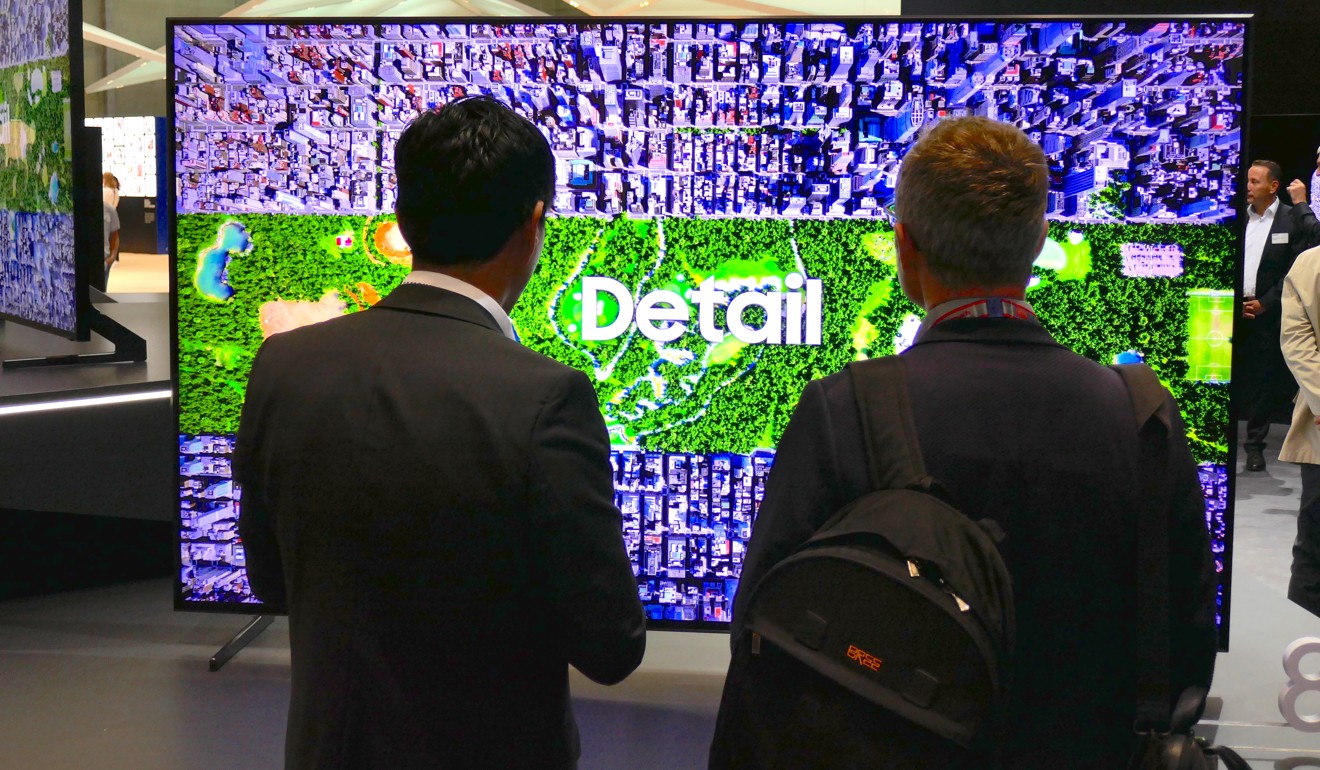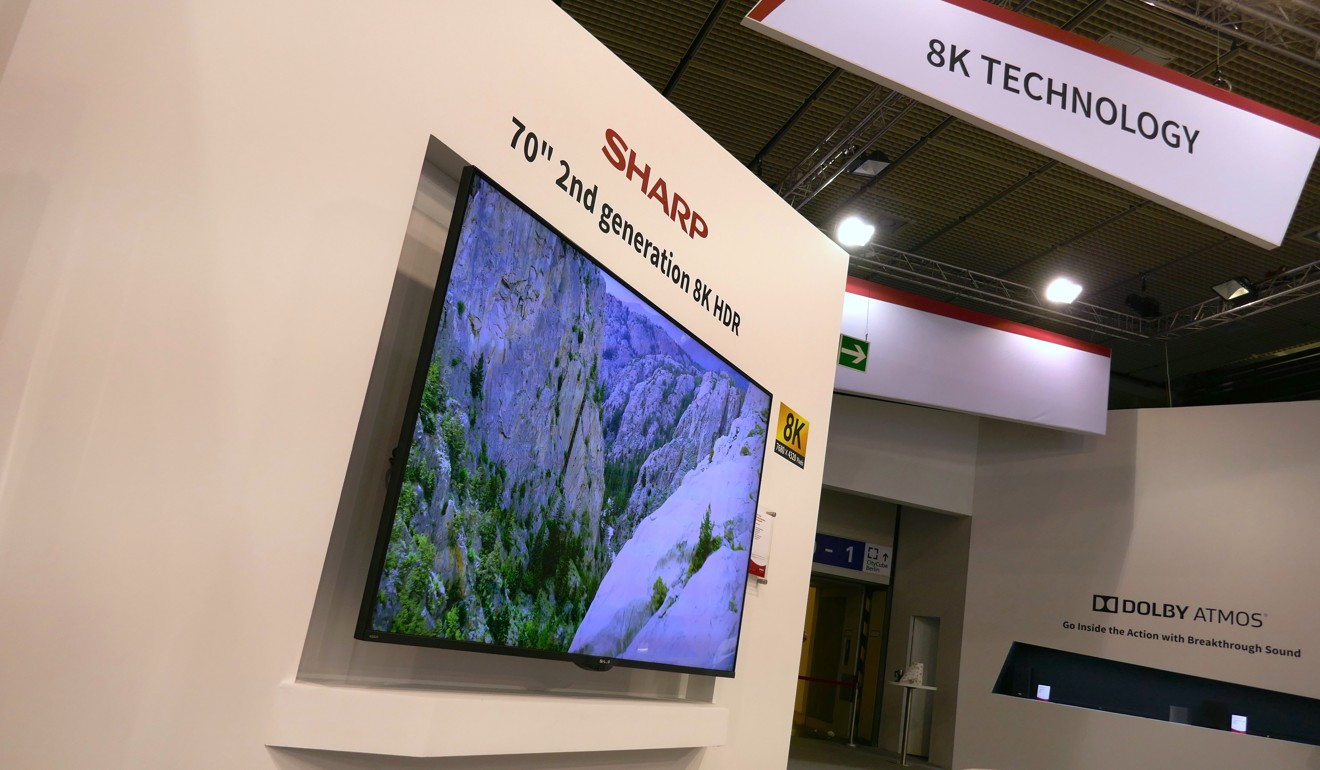
8K TVs at IFA 2018 tech show in Berlin to go on sale this autumn – expect ultra-premium prices
Newest TVs have resolution four times higher than 4K screens, but you’ll have to get within a metre of them to tell the difference
Berlin has seen a resolution revolution this week, as major television manufacturers in China, South Korea and Japan used the annual IFA tech exhibition to unleash 8K TVs.
For those who immediately wonder why anyone needs a super-high-resolution 8K TV, consider this: a 4K TV creates an 8- megapixel image, whereas an 8K TV’s 7,680 x 4,320 pixel resolution means a mighty 33 megapixels.
The complete guide to buying a TV
If you have a big enough screen, this means watching an action movie or playing a video game at home becomes a more immersive experience.
Judging by the number of exhibitors who showed off the technology at this year’s trade fair, some of the top electronics manufacturers in Asia are convinced that now is the time to make the first 8K TVs commercially available.
Despite concerns about exactly how bright such a huge 8K TV could be, the giant LG screen is proof that the fashion for 8K is a big money move. Though still in its infancy, the 8K TV market is expected to grow to more than five million units by 2022, LG said. The South Korean manufacturer said it was “committed to leading the ultra-premium market” with its 8K OLED TV technology. There is no word yet on pricing, but ultra-premium TVs are not going to come cheap.
“LG’s first 8K OLED TV is the pinnacle of technological achievement and the next evolutionary step in display technology,” said Brian Kwon, president of LG Home Entertainment Company. “4K OLED played a major role in reshaping TV industry and LG is confident that 8K OLED will do the same.”

Of the latest 8K TV launches, the most have come from another Korean manufacturer, Samsung, which unveiled not one, but four variants of its Q900R QLED 8K TV in 65-, 75-, 82- and 85-inch variants, all of which will go on sale in October. A QLED TV, the Q900R’s Quantum Processor 8K uses artificial intelligence to improve the upscaling from 4K to 8K resolution, Samsung said. In truth, most exhibitors at IFA 2018 claim their latest products use AI.
“Samsung has been able to make 8K LCD panels for some years [and] it has been solely a timing decision on when to launch a flagship model,” said Paul Gray, a research and analysis director with IHS Technology. “With 8K panels potentially accessible to all TV-set makers, I think Samsung’s move is largely defensive – with OLED having set the agenda in premium TV in the past year, Samsung does not want to appear lagging in technology.”

Though it was expected to announce its new 8K TV models, Sony’s AF9 series of OLED TVs turned out only to have 4K resolution. However, another Japanese brand, Sharp, filled the gap by previewing 60-, 70- and 80-inch versions of its AX1 8K TVs to be sold in Asia by the end of 2018.
The model is Sharp’s second-generation 8K TV; it has been selling its 70-inch LV-70X500E since the summer. Toshiba also showed a “concept” 8K TV, while Chinese TV manufacturer ChangHong had a 75-inch 8K QLED TV.

With 4K TV penetration approaching 40 per cent this year, and sales of 55-inch-plus TVs on the rise, TV makers are looking for the next big thing. Claire Wen, Taiwan-based principal research analyst at Gartner, said: “It’s a rational move for leading brands to promote or demonstrate premium features such as 8K in advance to maintain their leading positions.”
All of which left Berlin with one question: can anyone tell the difference between 4K and 8K? “Yes, you can see the difference, but you have to sit very close to the screen,” said Gray. “Broadcasters’ rule of thumb is that you need to be 1.5x the screen height away to see all the detail in 4K, and 0.75x for 8K, so prepare to sit a metre away!”
In short, the difference will be slight unless you are sitting very close to the screen, but phones are very often compared on their PPI – pixels per inch – so why not TVs?

“In principle, the viewing distance for TV-watching is about two to three metres, and the ideal PPI is about 60,” says Wen. “Therefore we can see the immediate difference between 65-inch with 4K versus 65-inch with Full HD, which are 68 PPI and 34 PPI respectively.” She explains that a 65-inch 8K TV has 135 PPI.
“That’s beyond what human eyes can tell compared to 4K TV,” she adds.
Made for Hong Kong microflats – big-screen TVs you can hide
The 8K technology won’t appear only in TVs. it is expected to be used for both virtual reality headsets and 140-inch video walls.
At IFA 2018, market analysts GfK reported that in the first half of 2018 it recorded global TV-set sales of US$52 billion . That’s a one per cent rise from the first half of 2017. GfK attributed the increase in part to this summer’s Fifa World Cup in Russia.

